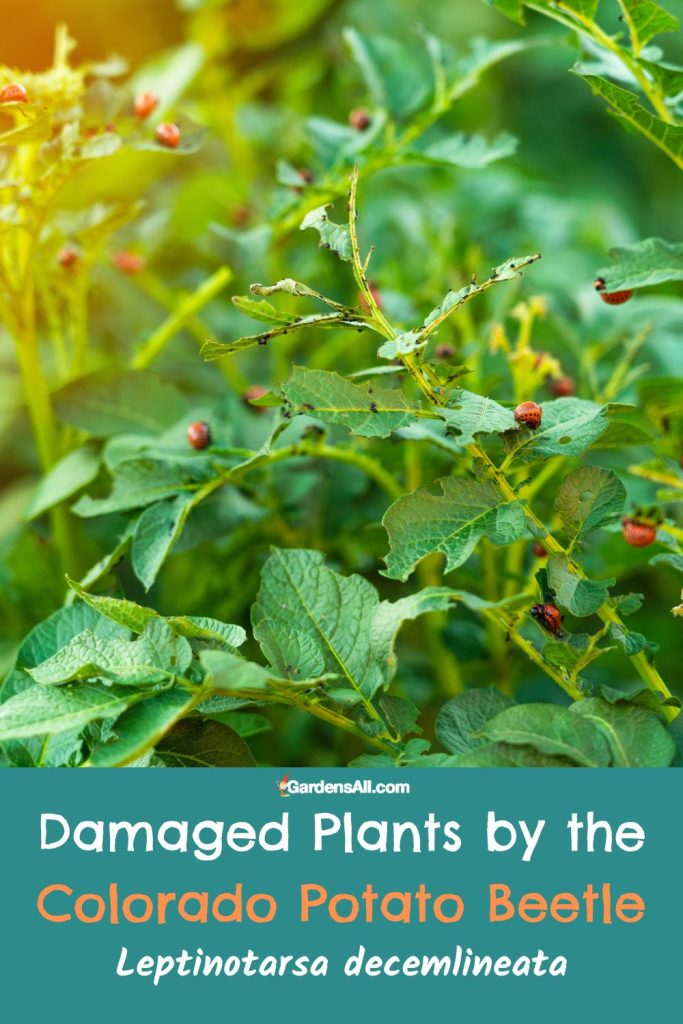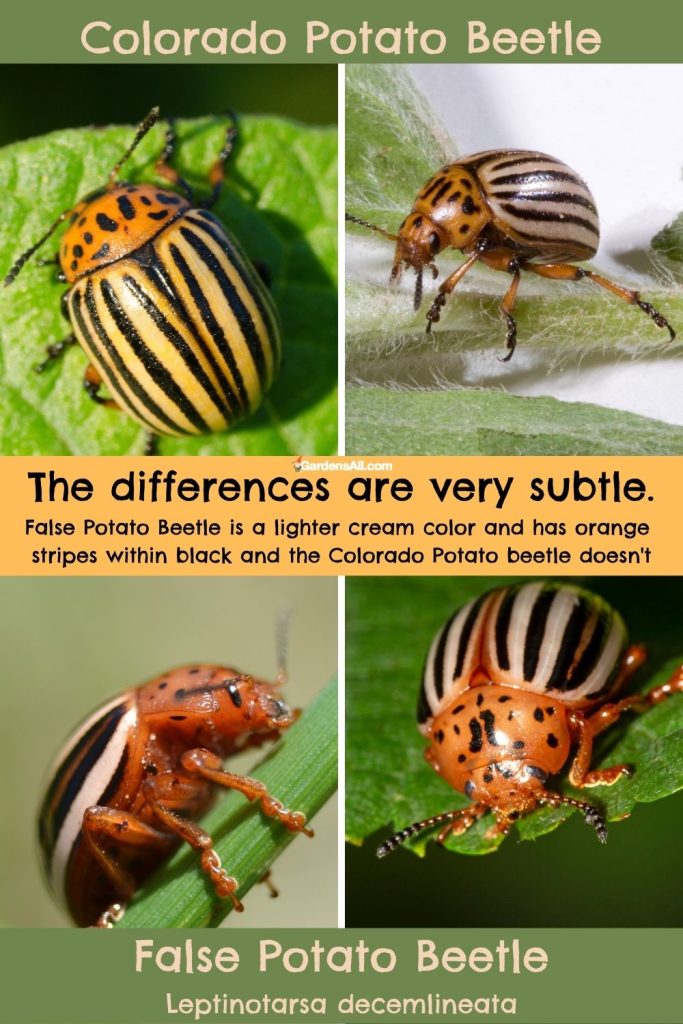If you’ve found them on your plants, you’ll be wanting to know how to get rid of potato beetles in the garden. The potato beetle is scientifically labeled Leptinotarsa decemlineata, and also called the Colorado potato beetle, but it doesn’t just attack potato plants.
We’ll cover how to get rid of potato beetles and the plants they attack shortly. But first we wanted to know what regions are most affected and also a little history, so sharing that next in case you’re also interested. (Or you can skip to it via the Table of Contents if you’re not interested in the regions and origins).
A Short History on the Potato Beetle
Where in the US is the Potato Beetle?
The potato beetle is widespread throughout the United States, and especially the Northeast and Midwest.
Why is It Called the Colorado Beetle?
The name “Colorado potato beetle” is somewhat misleading given the insect’s current distribution across the United States and other parts of the world. The beetle was first discovered in the Rocky Mountain region, specifically in Colorado, in the mid-19th century. At that time, it was primarily feeding on buffalo bur, a wild member of the Solanaceae (or nightshade) family botanically known as Solanum rostratum.
When settlers brought cultivated potatoes to this region, the beetle adapted and began feeding on these new plants, becoming a significant agricultural pest. It’s during this period that it gained the name “Colorado potato beetle.”
However, the beetle quickly spread beyond Colorado. It is highly adaptable and migratory, and it has been very successful in extending its range across North America and into other parts of the world. Despite this global spread, the name “Colorado potato beetle” has stuck.
If this isn’t the beetle causing damage on your plants, you may want to check our article on “bad beetles“.

Potato bug life cycle by Andrei Alyokhin via PotatoBeetle.org[1]http://www.potatobeetle.org/overview/#distr

Signs of Potato Beetle Damage
Colorado potato beetles (Leptinotarsa decemlineata) can cause extensive damage to potatoes and other plants in the nightshade family (Solanaceae), including tomatoes, eggplant, and peppers. Here’s how they typically affect these plants:

Damage from Potato Beetles
1. Leaf Damage & Defoliation: Both adult beetles and their larvae chew leaves and can strip plants down to the stems in short order if populations are high. They typically start at the top of the plant and work their way down.
2. Reduced Yield: The leaf defoliation impairs the plant’s ability to photosynthesize, which can reduce yield and even kill the plant if the damage is severe enough.
3. Plant Stress: Damage from potato beetles can stress plants, making them more susceptible to diseases and other pests.
4. Future Infestations: Female potato beetles can lay hundreds of eggs at a time, leading to future infestations that can further damage crops.
So what can you do? First, identify the culprits!
The Potato Beetle Life Cycle

How to Prevent and Get Rid of Potato Beetles Naturally
Monitoring your plants regularly can help you identify and address infestations early, before they cause severe damage. Implementing integrated pest management (IPM) strategies, including biological control, crop rotation, and use of resistant varieties, can also help keep potato beetle populations in check.
NOTE: Some of the prevention strategies are also employed as elimination strategies and vice versa, so please keep that in mind as you read through this list.
ELIMINATION: How to Get Rid of Potato Beetles
While prevention is vastly better than riddance, we’re listing the elimination strategies first because that’s what most people are desperately searching for now. However, once your garden’s health is under control, then you may find it helpful to review the prevention strategies and work on a plan to implement as many of those as possible.
1. Early Detection and Action
Swift action can significantly help in managing and mitigating potato beetles (or any garden pest). Regularly monitor your plants for any signs of these pests. Always consider an integrated pest management (IPM) strategy that includes a combination of the practices listed. This not only controls the pests but also minimizes the impact on the environment.
2. Handpicking
This method can be time-consuming, but it is effective especially for smaller gardens. Regularly inspect your plants for eggs, larvae, and adults. The eggs are typically orange or yellow and found on the undersides of the leaves, while the larvae are humpbacked and reddish with black heads. Remove and crush the eggs, larvae, and beetles when you find them.
3. Beneficial Nematodes
These microscopic worms live in the soil and can kill Colorado potato beetle larvae, and often these are available to purchase and release into your garden.
4. Use of Botanical Insecticides
In severe cases, you may want to consider using insecticides. There are options such as Spinosad and Neem that are considered organic methods. However, the beetles can develop resistance if the same product is used repeatedly. Always follow the manufacturer’s instructions when using insecticides.
For more elimination ideas, see also natural predators and row covers.
PREVENTION: How to Prevent Potato Beetle Infestation
1. Crop Rotation
Rotate crops every year to make it harder for the beetles to find the potatoes. These beetles will overwinter in the soil and emerge in the spring to find new host plants. If potatoes or other host plants aren’t in the same location, it reduces the beetle population.
2. Polyculture, AKA Companion Planting
In addition to rotating crops, another beneficial strategy is companion planting for plant diversity. This is the opposite of monoculture. We can consider that a singular crop planted in any area becomes a magnetic target for the pest that prey on it. Therefore, to interplant is an excellent practice that emulates the diversity within which nature grows.
3. Natural Predators
Encourage natural predators to live in your garden. Birds, ladybugs, lacewings, and predatory stink bugs are among the creatures that prey on potato beetles.
See also, birds that eat mosquitoes and bad garden bugs.
4. Row Covers
Using floating row covers can prevent the beetles from reaching your plants. These need to be installed after planting and removed during flowering so pollinators can reach the plants.
5. Trap Crops: Some gardeners use early-planting varieties of potatoes as ‘trap crops’. The beetles are attracted to the first plants that emerge, and once they’re established on the trap crop, you can remove and destroy these plants (along with the beetles).
6. Plant Beetle-Resistant Varieties
Resistant varieties can indeed play a key role in managing Colorado potato beetles, particularly in a home garden setting. However, it’s important to note that “resistance” can vary, and even resistant varieties may experience some level of damage in the presence of a high beetle population.
Here are a few varieties that have been reported to show some level of resistance to Colorado potato beetles:
- ‘Elba’: This variety has shown a good level of resistance to Colorado potato beetles. Elba potatoes are late-season and produce large, round tubers with white skin and flesh.
- ‘King Harry’: This variety has been genetically modified to have hairs on its leaves and stems that discourage the beetles from feeding.
- ‘NewLeaf Y’: This is a genetically-modified variety that has been engineered to express a Bt toxin that kills Colorado potato beetle larvae.
- ‘Russet Burbank’: While not completely resistant, this variety is less attractive to Colorado potato beetles compared to some other common potato types.
Availability of these varieties may vary, so it’s worth checking with local nurseries, extension services, or seed catalogs for the best options in your area.
And remember that while these varieties may offer some level of resistance or deterrence, they’re not completely immune to Colorado potato beetle. So focusing on IPM and the preventive measures we’ve covered, will go a long way toward protecting your crops.
Beyond that, starting with good soil (see soil testing) and applying good organic fertilizers will help your plants fight off and survive attacks in much the way our own healthy immune systems help us to.
The False Potato Beetle – a Potato Beetle Look-alike
The Colorado potato beetle and the false potato beetle are two different but closely related beetle species that are often confused due to their similar appearances.

| Characteristic | Colorado Potato Beetle (Leptinotarsa decemlineata) | False Potato Beetle (Leptinotarsa juncta) |
|---|---|---|
| Size | About 3/8 inches long | About 3/8 inches long |
| Color | Yellow-orange body | Typically a paler cream colored body |
| Stripes on Elytra (hardened wing covers) | 10 distinct black stripes | Fewer black stripes (4 or 5), broken by orange stripes in between down the center and on each side. |
| Larvae Appearance | Soft, hump-backed grubs that can be red or pink with black spots | Similar to Colorado potato beetle larvae |
| Preferred Diet | Potatoes, tomatoes, eggplants, and peppers (Members of Solanaceae family) | Typically feeds on non-crop plants in the nightshade family like horsenettle and buffalo bur, but can sometimes be found on potato plants |
Colorado Potato Beetle vs. False Potato Beetle Appearance Description
1. Colorado Potato Beetle (Leptinotarsa decemlineata): This beetle is a major pest of potato crops. It is around 3/8 inches long with a bright yellow-orange body and 10 distinct black stripes running down its elytra (hardened wing covers). It also has a noticeable black spot on each side of its thorax.
2. False Potato Beetle (Leptinotarsa juncta): The false potato beetle looks quite similar to the Colorado potato beetle but is generally less of a pest. It is about the same size but has a more pale yellow color and fewer stripes on its elytra (usually only 4 or 5). Another distinguishing feature is the absence of the black spot on the side of its thorax, which is present in the Colorado potato beetle.
Both of these beetles belong to the family Chrysomelidae, and their larvae are similar in appearance: soft, hump-backed grubs that can be red or pink with black spots.
Reference: Univ. Florida Entomology & Nematology Dept.[2]https://entnemdept.ufl.edu/creatures/veg/leaf/potato_beetles.htm
What Do Potato Beetles and False Potato Beetles Eat?
While the Colorado potato beetle is a significant pest of potatoes and other solanaceous crops, the false potato beetle usually feeds on plants in the nightshade family that are not crops, like horsenettle (Solanum carolinense) and buffalo bur, (Solanum rostratum). However, the false potato beetle can sometimes be found on potato plants, especially if their preferred food sources are not available.
The Bottom Line?
Whether it’s the Potato Beetle or the False Potato Beetle, the bottom line is that if you see either one on your nightshade plants, you will want to take action to remove them!

For more on battling bad beetles…
I’m LeAura Alderson, a garden, herb and plant enthusiast with a passion for discovering the many edible and medicinal benefits of the plants all around us, including the weeds! I’m a writer, editor and media publisher for our family of websites.
While I was certified in fitness and life coaching, I am NOT a health practitioner. However, I’m a lifelong health enthusiast, with a keen interest in healthy, organic foods and making home remedies and the content we share is from our own experience and usage as well as that extracted from scientific research so that you can explore further on your own.
Always seek the advice and guidance of your health practitioners first and foremost.
As a family we’re steadily expanding our gardening, experimentation and knowledge around all things gardening, edible landscaping, fresh organic foods and self sustainability with farming in our future. I also own and manage iCreateDaily.com, a site all about transformation through creation, and the power of positivity, optimism and mindset.
References

